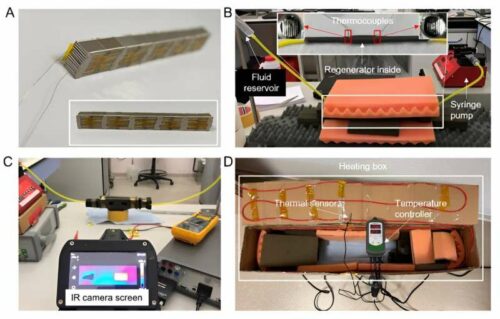Discover how this fluid-based design surpasses traditional air conditioners, achieving remarkable efficiency while reducing environmental impact.

In collaboration with Murata Manufacturing Company, engineers at the Luxembourg Institute of Science and Technology have unveiled a groundbreaking cooling and heating technology advancement. This regenerative electrocaloric heat pump surpasses the efficiency of traditional air conditioners. Their findings, published in the prestigious journal Science, demonstrate this innovation’s potential to revolutionise how we control indoor temperatures.
Traditional cooling and refrigeration systems rely on vapour compression, a process known for inefficiency and harmful environmental impact. Seeking an eco-friendly alternative, scientists have been exploring solid-state electronic heat pumps. These devices typically employ ferroelectric materials exposed to an electric field, inducing temperature changes. While this approach has promise, developing a commercially viable electrocaloric heat pump has faced numerous challenges.
The research team has taken a different route by introducing a fluid-based design, yielding prototype devices that outperform conventional air conditioners. Their approach involves stacking strips of lead scandium tantalate and immersing them in silicone oil chosen for its excellent heat-conduction properties. When an electric current is applied, the strips heat up, causing the fluid to move in one direction. The fluid flows in the opposite direction upon cooling, creating a temperature difference of approximately 20°C. The oil circulates throughout the system to utilise the device as a heater or air conditioner. Rigorous testing has demonstrated that the device can achieve 64% of Carnot’s efficiency, a remarkable accomplishment considering the theoretical limits of such technology.
While these results are promising, the research team acknowledges that further work is needed to optimise the device’s performance in real-world applications. Nonetheless, this electrocaloric heat pump technology breakthrough represents a significant step forward in the quest for energy-efficient and environmentally friendly heating and cooling solutions. Jaka Tušek, from the University of Ljubljana in Slovenia, has also contributed to the discussion by offering valuable insights in a Perspectives piece published in the same journal. His commentary sheds light on the underlying principles of electrocaloric heat pumps and highlights the groundbreaking work carried out by the research team in this innovative endeavour. As scientists and engineers continue to refine this technology, we can anticipate a future where heating and cooling systems are more efficient and sustainable, contributing to a greener and more environmentally conscious world.







